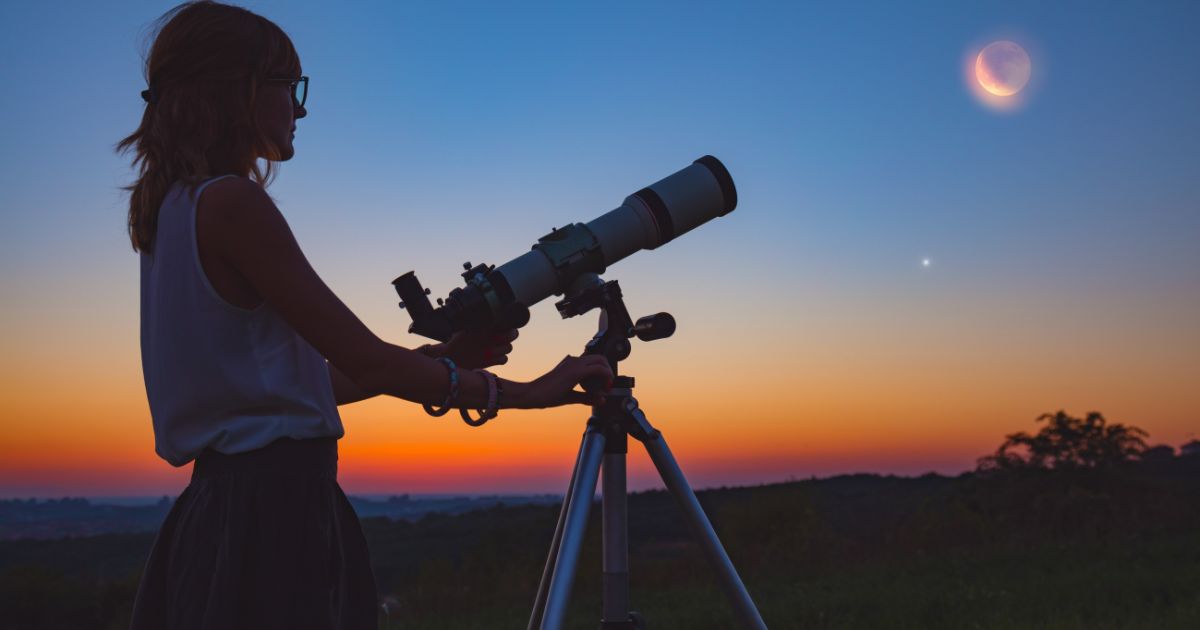One of the best-kept secrets of the outdoors is the sky at night. Even most cottagers don’t venture out after dark. There is almost nothing to see outside when you first step out from a lit room, as the illumination suddenly drops by 100,000 times! And yes, the mosquitoes take only about 10 minutes to find you—about the amount of time your eyes need to adapt to the darkness. If you survive long enough for the bugs to start feeding, you may see only a few stars twinkling through the dense tree canopy.
This is where urbanites may have it over cottagers: few mosquitoes and fewer trees. When astronomy clubs announce they will be setting up telescopes at shopping mall parking lots, they can attract hundreds of people. There can be dozens of people in each lineup for a telescope, or they gather around guides who point out the stars and regale the would-be stargazers with stories, mythologies and the science of the stars and planets. Harrowsmith editor-in-chief Jules Torti has written about her perspective on rural and urban astronomy (harrowsmithmag.com/6475/where-the-stars-align-in-canada).
In rural areas we can still revel in those quiet nights under a dark sky, but most of the familiar public urban activities need to be reworked. In 2020, these public gatherings have become, temporarily, unpopular or unwise. So amateur astronomers have adopted other techniques to share their love of the night sky. And the public has adapted, too, deferring the communal experience of observing the night sky under a planetarium dome. So, when reading articles about the latest astronomical discoveries becomes a bit “old,” what can we do to widen our minds beyond our earthly concerns?
Even before 2020, telescope owners were sensitive to the long lineups at public star parties. So a few began mounting sensitive video cameras to their telescopes, feeding the telescopic views to large video monitors so they could show them to dozens of people at a time.
Some have now taken the next step and are streaming these views through their telescopes online (known as “Astrocasting” or “I-Casting” ). With social distancing becoming the “in thing,” instead of driving their telescopes to half-empty shopping mall and library parking lots, they stream the video views, along with their narrated knowledge, over the internet from their homes and observatories.

The enabler for this experience is a small astronomy video camera that mounts to a telescope like an eyepiece, a lens that directs the light from the telescope into the observer’s eye. A very popular Canadian astro-video camera is the MallinCam (mallincam.net), which costs about as much as a good eyepiece.
These new cameras are almost better than visual observing. Because your eye builds up an image on your retina in only about 1/10 of a second, you won’t see any of the fainter details the longer you look.
These video cameras, however, build up images over many seconds, so what you see on your video monitor is a detailed image in full colour. Instead of seeing a “faint fuzzy” in a telescope, you see a galaxy’s spiral arms or the turbulent structure of an emission nebula in real time!
There is a second benefit offered by these “astrocasters.” One or two nights out of three are cloudy, but thanks to astrocasters, that is no longer a problem. Viewers can tune in to an observer on the other side of the country who has clear skies, or on the other side of the planet so they can see what’s going on at a more convenient hour, such as during their daylight times.

Of course, everything has its limits. These “broadcasts” are provided freely by amateurs when they are able to get out to observe, so there is no set schedule. The only website I know of to access these broadcasts is nightskiesnetwork.ca.
There is a small notice at the bottom of the front page that will let you know if anyone is currently broadcasting. Because it is nice to know how many are taking advantage of their voluntary efforts, they would like you to sign up to watch. There are probably other similar websites, but this one is a start.
One of Canada’s foremost writers and educators on astronomical topics, the Almanac has benefited from Robert’s expertise since its inception. Robert is passionate about reducing light pollution and promoting science literacy. He has been an astronomy instructor for our astronauts and he ensures that our section on sunrise and sunset, stargazing, and celestial events is so detailed and extensive it is almost like its own almanac.













